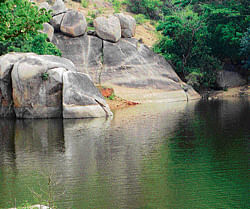
Chandravalli, a cave temple near Chitradurga, is also a pre-historic site. Amrith Jogi visits the cave temple and is spellbound by the many secrets it holds.
We were sitting 80 feet below ground level inside the Chandravalli cave temple when our guide asked us, “do you know what absolute darkness means?”
Without waiting for our reply, he switched off his six-battery torch. It turned pitch dark and the silence that enveloped us added to the excitement. My eight-year-old held me tight, scared of the darkness.
The cave temple is around three km from Chitradurga district. It is a pre-historic site which is semilunar in shape. This temple is located in the midst of three hills, Chitradurga, Cholagudda and Kirubanakallu. A lake adds to the charm of this picturesque cave temple. The cave is located between two giant monolithic rocks. One of these rocks is also a rock climber’s favourite. The cave is also known as the Ankali Mutt. Legend has it that saints from places such as Ankalagi and Belgaum came here to meditate here.
Its religious importance apart, the cave is also a treasure house of stories. Having stepped into the cave, at no point will you feel that you are below ground level. Except for a few entrances you can pass almost every entrance without ducking.
Surprisingly, though it is difficult to see a ray of light, breeze welcomes you. There are corridors to ensure ventilation in this cave. One simply can’t help but wonder at the amazing engineering that has gone behind this creation. This cave has been created under huge boulders about 120 feet high and has withstood the test of time. If you enter the cave without a guide, the chances of your losing your way are high. The cave has a different exit route.
The cave consists of a place of worship with a Shiva linga, visitors’ room, rooms for sadhus, shelves that can hold belongings, carvings and paintings on the walls. It has a pooja place, bathroom, bedroom and even a library.
The cave also has a water outlet. There are many niches inside the cave that can hold lamps. There is a spot where one relax inside the cave and it has been designed in such a way that the person inside can see the visitor but not vice versa.The cave has many secret doors and resembles a maze. But a guide can help you take the right path.
On reaching the rahasya sthala, the last point which is a secret spot, our guide turned off his torch. He explained to us that this place was used as a hiding spot for kings. Secret meetings were known to take place here. The guide warned us about the many bats that abound this place.
Chandravalli is an ancient archaeological site. Historians have found painted pottery and coins from the Shatavahana empire and the pre-historic period. Excavation reports show that human habitation existed here even during the Iron Age.
There is also a rock inscription of King Mayurasharma, the founder of the first Kannada dynasty, the Kadambas, dating back to 450 CE.
A rock inscription can be found in the Bhairaweshwara temple at Chandravalli. Stone carvings indicate both Hindu and Buddhist influences.
The paintings have been done using vegetable colours and they have managed to stand the test of time.
Mythological significance
Chandravalli was earlier known as Chandanavati. Mythology has it that this place was once ruled by Chandrahasa, a king of Kuntala. The name, Chandravalli, is attributed to this king by some scholars.
Another explanation has it that the place was named Chandravalli because it was moon shaped. Experts such as R Narasimhachar, B L Rice and R Shamashastry carried out excavation work here in the year 1909. It gathered momentum after the significant contribution of M H Krishna between 1929-30.
Mortimer Wheeler who was the director general of the Archaeological Survey of India completed the work in 1947.
These findings and some inscriptions found in the surrounding areas have revealed that Chandravalli has been home to human habitation ever since the megalithic age and neolithic age.
It also was the home of kings belonging to Kadamba, Shatahavahana and Hoysala dynasties.
Some of these relics have helped in taking the ancestry of Chandravalli to at least two thousand years.
The place is now under the protection of Archaeological Survey of India (ASI).